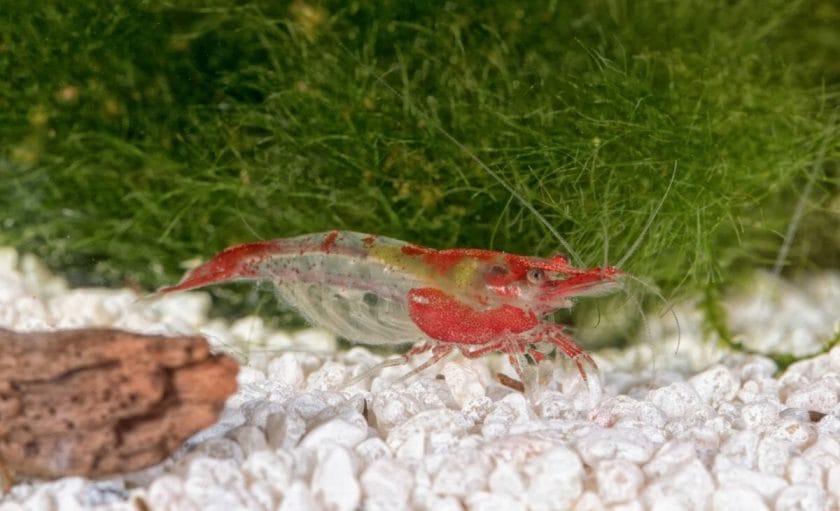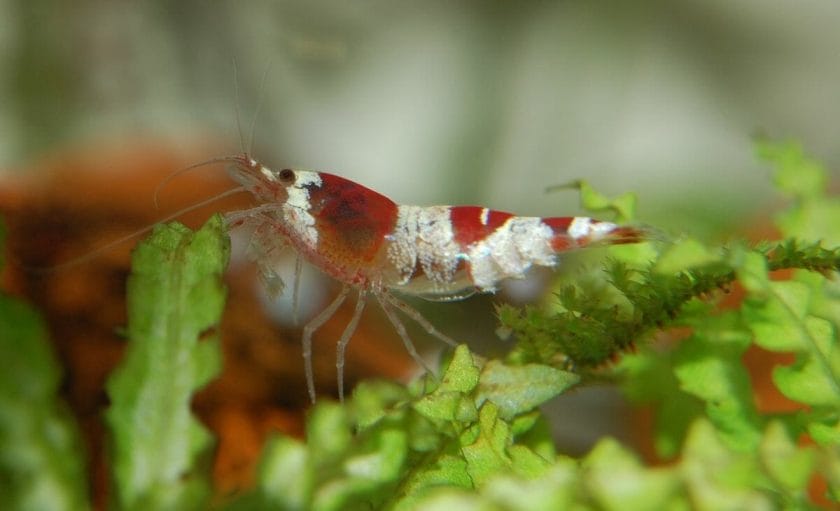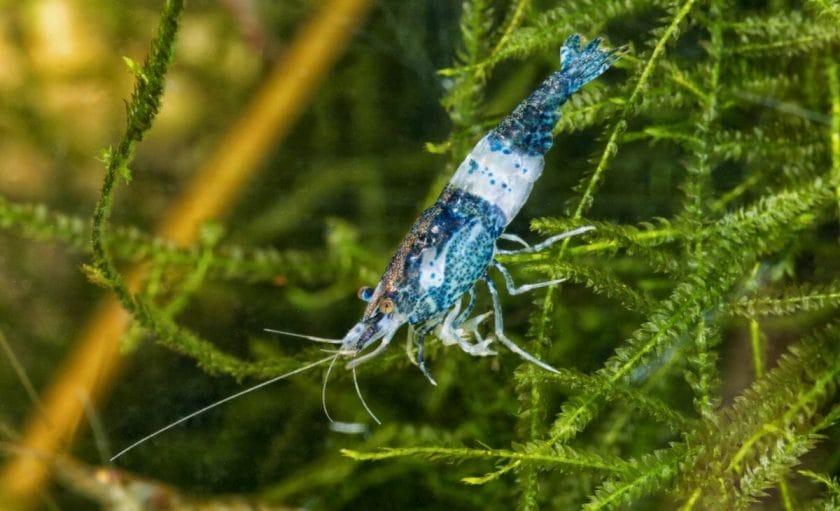Shrimp tanks often have different setups than traditional aquariums, but is it still important to cycle the tank?
Cycling your tank is important to create ideal living conditions for your shrimp. Without it, your shrimp will be exposed to high ammonia concentrations that can harm or even kill them.
Read this article to explore why shrimp tanks need to be cycled and see a step-by-step guide to cycling your shrimp tank.

Table of Contents
Why Cycling Your Shrimp Tank Is Important

Cycling your tank is essential, regardless of what kind of aquatic life you’re planning on putting in there. Whether it’s shrimp or fish, you need to cycle your tank to prevent a buildup of harmful toxins. Doing so involves a process called the nitrogen cycle.
It Maintains the Nitrogen Cycle
The end goal of cycling your tank is to have the ‘good’ bacteria keep up with the ‘bad’ bacteria. This biogeochemical process is called the nitrogen cycle, and it converts nitrogen into various forms, eventually winding up in a healthy balance that creates livable conditions for fish and invertebrates.
First, nitrogen is converted into ammonia as a result of decaying organic matter or waste. Then, the ammonia is converted to nitrite via the oxidation of ammonia.
Lastly, nitrobacter converts nitrites into nitrates, the least toxic of these compounds and something that’s manageable and harmless in low concentrations in an aquarium.
To recap, here’s a simple step-by-step overview of the process.
- Fish or organic matter produces ammonia
- Ammonia is converted to nitrite
- Nitrite is converted to nitrate
It Prevents Ammonia Buildup
Cycling your tank is important to prevent a buildup of ammonia as a result of the fish waste. In a pond or river, rain and natural water flow dilute harmful concentrations, allowing the fish to thrive.
In a closed ecosystem, on the other hand, you need to ensure that the bacteria are present in the filter media to convert harmful ammonia compounds into something inert.
Ammonia is painful for fish who are exposed to it, and it can burn their eyes, gills, and fins. The same is true of shrimp, which can die when exposed to even low concentrations of it.
Compared to other tank inhabitants, shrimp are extremely sensitive to changes in water conditions and are much more likely to perish when exposed to high concentrations of ammonia, nitrite, or nitrate.
Of course, even when your tank is cycled, you still need to conduct regular water changes. Nitrates are harmful in large concentrations, too, which is why diluting the water every week or every other week is important, as well as regular testing.
How to Cycle a Shrimp Tank

The goal of cycling your tank should be to zero out your ammonia and nitrites, indicating that the ‘good’ bacteria that break down these two compounds are keeping up with the waste production in your tank.
The cycle is complete once you can feed your shrimp regularly, keeping ammonia and nitrite levels zeroed out, while nitrate levels are slightly above zero. When the concentration of nitrate rises to above 40 ppm, then it’s time to do a water change, a process you’ll need to repeat on a regular basis.
Here’s what you’ll need to kickstart the process:
- An ammonia source
- A sponge filter
You may also want to set up the following in your tank before introducing your new inhabitants:
- Substrate
- Live plants
- A light
- Heater
There are three ways to cycle your tank that we’ll discuss: fish-in cycling, fishless cycling, and cycling with aquarium plants.
Fish-in Cycling
Fish-in cycling is generally done with fish, not shrimp. Because shrimp have an extremely low bioload, which means low ammonia production, the nitrogen cycle can take a very long time to kickstart.
Moreover, shrimp are extremely susceptible to changes in water condition, so fish-in cycling is not feasible or recommended for shrimp tanks.
Before you introduce fish or shrimp to your tank, you need to ensure that the natural process of the nitrogen cycle is strong enough to handle new sources of ammonia from your shrimp and fish.
How Often Should I Change Water When Doing a Fish-in Cycle? (Answered)
Fishless Cycling
The preferred method to start the nitrogen cycle is by adding beneficial bacteria from the get-go.
If you have other aquariums (or a friend who has aquariums), transplant some of the filter media or substrate from the established tank to the new tank.
Don’t use water, since just plain old water doesn’t have enough beneficial bacteria to do much in cycling your tank. If you don’t have prior filter media from an established tank, then you can use fish food to invite ammonia. It’s not as quick, but as long as you’re committed to wait 4-6 weeks for the cycling process to finish, then it’s a workable solution.
You can also use a cycling kit such as FritzZyme 7 Nitrifying Bacteria to boost your beneficial bacteria sooner. Regardless of what starter method you use, you’ll need to monitor your tank conditions carefully to ensure that the nitrogen cycle is moving along as expected.
API offers a range of test kit products that can help you monitor pH, ammonia, nitrites, and nitrates in your tank. You could also get an API master test kit which you can use to test pH, ammonia, nitrite, and nitrate.
Plant Cycling
Perhaps the best way to cycle a shrimp tank is with plants. That’s not to say that cycling with plants is healthier or more optimized than the other methods, but shrimp and live plants go together wonderfully, so you might as well introduce your shrimp to an environment with well-established plants.
Plants make a great place for shrimp to hide, breed, and forage for detritus; besides, different plants make for a beautiful splash of color. Check out our handy guide to the best plants for shrimp tanks to learn more!
Instead of setting up a bare tank, introduce your shrimp to a rich, natural environment to really bring out their color and make the aquarium a more natural biosphere.
Add some suitable live aquarium plants and grow them with the appropriate lighting, fertilization, and substrate.
Aquatic plants consume ammonia waste, so when you introduce an ammonia source, your plants will take care of the rest. The leaves and the roots also produce beneficial bacteria, helping your tank get started on the right foot.
Once the plants start to show growth, then the cycling is complete and the plants are effectively consuming the ammonia and nitrites.
When done, you can add a few fish and feed them sparingly–you wouldn’t want to spike your new tank with ammonia from that leftover food!
How to Maintain Your Shrimp Tank

Once you’ve got your shrimp tank cycled and ready to go, you’ll need to keep it that way.
First, consider the preferences for your species of shrimp. Some, like the Caridina shrimp, prefer low pH water, while Neocaridina prefer higher pH levels.
Regardless of what shrimp you have, consider including these in your tank to create an ideal living environment and increase longevity:
- Substrate
- Hardscape materials (rocks, driftwood, logs)
- Filter
Your best bet is a sponge filter, which is small and low maintenance, only needing cleaning every couple of months.
An aquarium light can help a lot if you’re trying to get a flourishing planted tank, and a heater can keep parameters stable, although you don’t necessarily need one.
Feeding Your Shrimp
You may already know that shrimp feed heavily on algae. While it does make up a significant portion of their diet, some variety will benefit your shrimp.
Feed the tank every few days with a variety of shrimp pellets, veggies, and algae wafers. I use Hikari Shrimp Cuisine since it dissolves easily, and the shrimp love it!
Water Changes
When your nitrate levels hit a concentration of 40 ppm or higher, it’s time for a water change. Dilute 50% of the water weekly or biweekly for best results.
Every now and then, you should use the siphon to remove trapped dirt and debris from under the surface layer of substrate.
FAQs

Do Shrimp Need a Day/Night Cycle?
Shrimp do need a day/night cycle, just like in the wild. They need light to find their food, and the algae that they feed on also need light. Leaving your aquarium light on 7-8 hours a day at minimum is best since it promotes algae growth. Light is also essential if you have live plants.
What Temperature Should a Shrimp Tank Be?
Most shrimp prefer a temperature from 68 to 82 degrees, although different species of shrimp prefer different water temperatures, and some species are capable of adapting to a wider range of temperatures.
Most shrimp are, however, quite sensitive to change, so once you establish the perfect temperature, stick to it.
Conclusion
Shrimp need cycled water just the same as fish do. In fact, shrimp are extremely sensitive to changes in water conditions, and a high concentration of ammonia will drastically shorten their lifespan.
Cycling and maintaining your tank will help your shrimp thrive under stable conditions, and it’s important to test your aquarium water regularly to detect and address problems before they threaten the health of your shrimp.
Pay attention to the helpful cycling guide provided above to give your shrimp tank the best start and allow your shrimp to have the best quality of life!
Besides, here’s an article showing the fastest ways to cycle a fish tank.